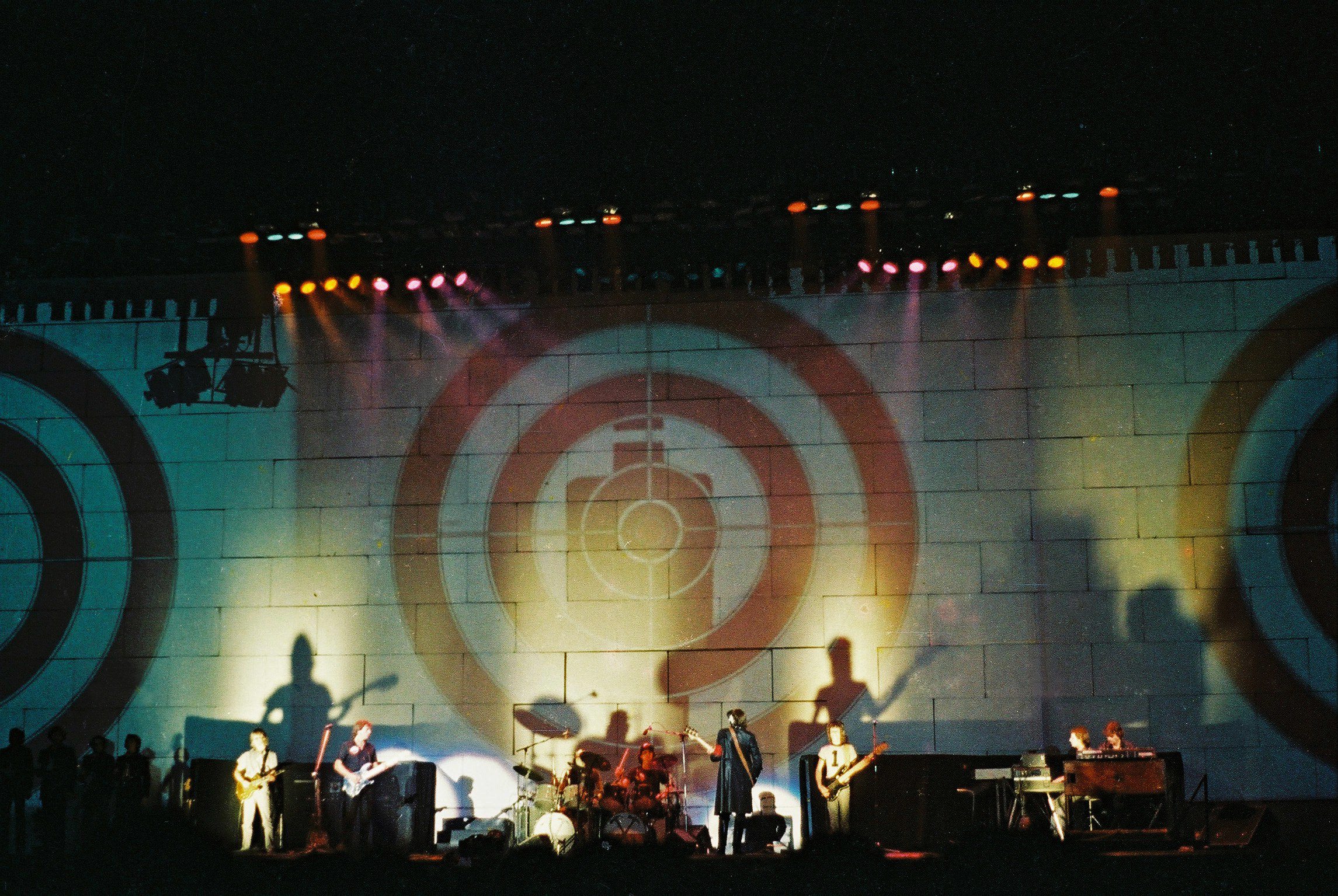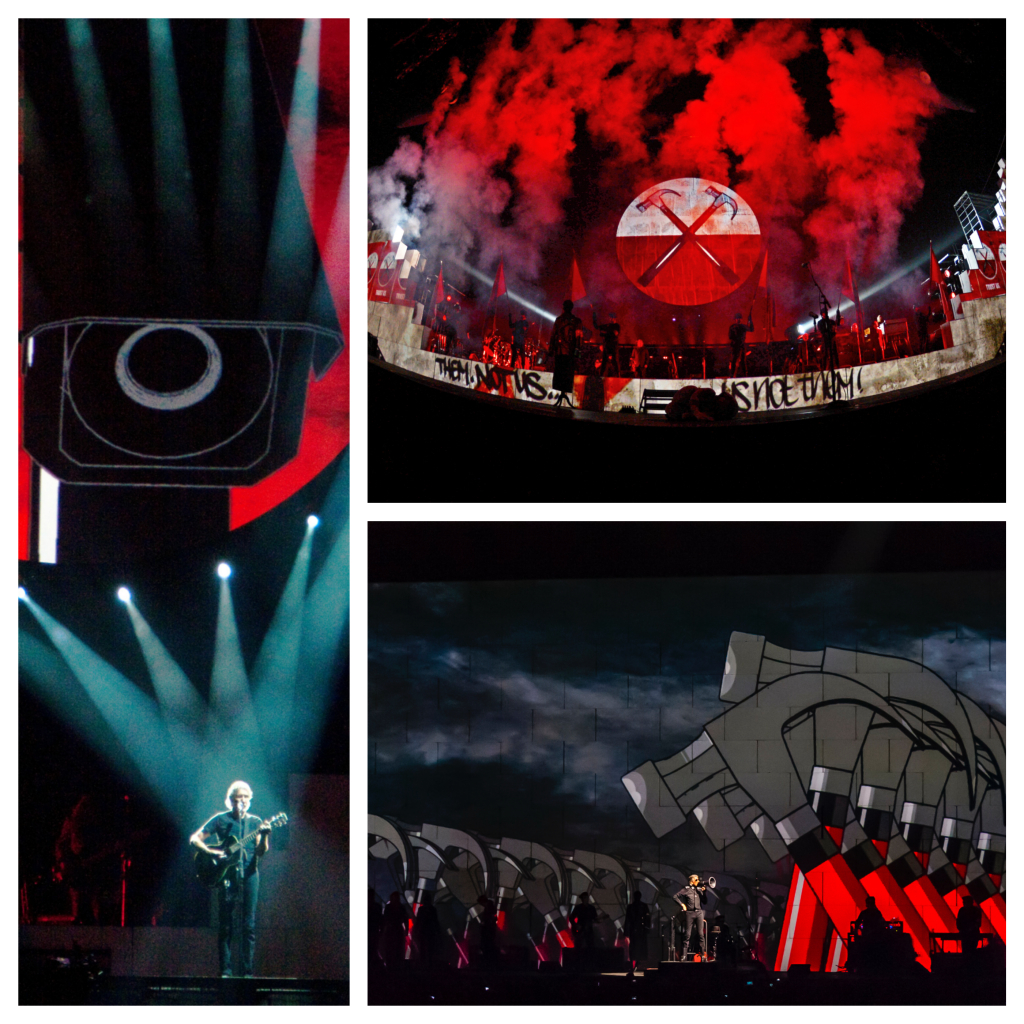In 1980, Pink Floyd’s de-facto leader Roger Waters redefined the concept of a rock show, in an experiment that threatened his solvency, tested his sanity and ultimately split the band. But that didn’t stop him rebuilding The Wall in 2010, exorcising his personal demons in the process.
Bricks. Hundreds of them. Spanning the stage. Scraping the rafters. It’s February 7, 1980, and the Los Angeles Memorial Sports Arena has never seen anything quite like the debut performance of Pink Floyd’s The Wall. During the first part of the show, a blockade has been built between us and them. Now, 45 minutes later, a one-brick hole remains, where Roger Waters stands, picked out by spotlights, singing the eerie, valedictory Goodbye Cruel World. As he delivers the kiss-off, ‘Goodbye’, a final brick flips into position and he is entombed. Blackout. House lights up. End of Act One.
It’s fair to say The Wall tour of 1980/81 was the antithesis of the no-frills rock’n’roll schlep. As challenging and bitingly satirical as its 1979 parent album, the 31-date odyssey (and Alan Parker’s subsequent 1982 film) had been floated, in embryonic form, right from the start.
“When Roger conceived The Wall,” Floyd artist Gerald Scarfe told this writer, “he told me he wanted to make it into an album, then into a show, and finally into a film. We got on well. We had the same ironic-stroke-sardonic view of the world.”
That world view was apparent on the album, Floyd’s eleventh, for which Waters presented his bandmates with a narrative tracing a picaresque anti-hero, Pink, through a wretched childhood, brutal education, failed marriage and hollow stardom, all under the cloud of his father’s death at war.

“Dark Side Of The Moon comes higher in my estimation, partly because it was more pleasurable,” said Nick Mason, recalling the fractious sessions that eventually saw Rick Wright demoted to a waged musician. “But The Wall is an extraordinary piece of work.”
Pink, of course, was a proxy for Waters himself, whose own father had perished at Anzio in 1944. “In its essence The Wall was an autobiographical work,” he told the BBC. “I grew up carrying a burden of a huge sense of guilt. I probably felt responsible for my father’s death. I had recurrent dreams I’d murdered somebody and I was going to get found out.”
As for The Wall’s iconography, the flashpoint came in Montreal, when Waters spat at an unruly fan during Floyd’s 1977 In The Flesh tour. “I felt this extreme feeling of alienation from these hundreds of thousands of people, all swilling beer and hooting and shouting,” he explained. “I suddenly had a visual image of an arena with a wall built across it and a band performing behind this wall.
“I remember thinking: ‘This is a great idea.’ So I started to talk to the other guys in the band, and of course everybody thought I was completely insane.”
Even before the release of The Wall in November 1979, Waters was spitballing concepts for the show with Gerald Scarfe, designer Jonathan Park and architect Mark Fisher, the four men pushing figurines around a scale-model stage like field marshals.
“Most of us assumed these concerts would just involve a slightly bigger PA system and a few lasers,” said Floyd’s sound-crew chief Robbie Williams. “When we first heard he wanted to build a wall, with the band performing behind it, we all said: ‘You’ve got to be fucking mad!’”
The Wall was not rock’s first grand-folly extravaganza – the bar had been set in 1975 by Rick Wakeman’s King Arthur On Ice ice show – but nobody had attempted a show on this scale before. Unveiled in Los Angeles, the titular edifice comprised 450 cardboard bricks (each measuring 5ft x 2.5ft) that slotted into a steel frame to create a wall standing 33ft tall and 260ft wide, with gaps opening to frame scenes and sub-plots. Three stages accommodated 12 musicians and 45 tons of equipment, pumping out 106 decibels of quadraphonic sound.
The multi-sensory assault continued. Arrivals at the Memorial Sports Arena were entertained/insulted by the sardonic patter of a local radio DJ (“Guess we’re all gonna make a lot of money off you guys…”), before the set began in duplicitous fashion with a so-called surrogate band (a quartet of session musicians playing The Wall song In The Flesh while wearing masks of the corresponding Floyd members’ faces).
Further highlights included a Stuka bomber that crashed and burned, the return of the Fairborne pig, ghoulish inflatables of Scarfe’s characters from the gatefold sleeve, and his nightmarish animations, including ‘marching hammers’ projected on to the backdrop.
Meanwhile, David Gilmour had the unenviable task of choreographing the music and visuals. The guitarist had a 6ft-long cheat-sheet pinned to his amplifier. Surrogate band drummer Willie Wilson recalled: “You had to play it exactly the same every night, so that you were in time with the animations, the films, the marching hammers, the whole show. So I would be wearing cans, listening to Dave’s voice counting down bars. Everything worked to a cue.”
Even so, accidents happened. “There was one hitch on the first night in LA,” Nick Mason told Record Collector. “At the beginning, there’s an explosion. It ignited a curtain at the top of the auditorium. We carried on for a while, then there were carbon dioxide canisters going off, and we put the house lights up, and stopped the show until they’d put the fire out.”
The tour went to New York, then rolled onward to Europe, stopping at each venue for a semi-residency through financial necessity. “Roger was against us doing stadiums,” Gilmour noted of the relatively slim itinerary. “And while it would have been nice to do a few more shows, it was unworkable to do it any other way than indoors. Plus the day-to-day running costs were enormous.”
Indeed the tour was haemorrhaging money. Waters later reported it lost the band $600,000, and Mason described the production as “absurdly expensive… simply not feasible”. Moreover, it was exacerbating existing frictions in the group; the demolition of the wall at the end of each night provided a glib metaphor for the crumbling band.
“I remember [playing] Earl’s Court,” Waters told Billboard. “We had separate trailers as dressing rooms, the four of us, and all the doors faced outward. There was so little community by then.”
On August 17, 1981, Pink Floyd performed The Wall for the last time as an ensemble. Two years later The Final Cut proved a prophetic album title, with Waters exiting for a solo career and spitting venom at his old bandmates until their brief reunion for Live 8 in 2005. Apart from the one-off solo performance by Waters in 1990 on the site of the fallen Berlin Wall, few imagined anyone would have the balls or the bank balance to restage the show.

Then, in April 2010, came the revelation: Waters would perform an initial run of 35 north American dates to mark The Wall tour’s 30th anniversary. “Last year I was thinking: ‘Well, what am I going to do?’” he told the BBC. “Shall I just play golf, or garden, or go into politics, or have I got one more of these in me?’ I’m sixty-six now. So I thought: ‘I think I have got one more’.”
The world had turned since the original The Wall tour, and as the creative team regrouped they realised what was impossible in 1980 was now just a mouse-click away. “The technology has changed beyond measure,” said Mark Fisher. “We had no mobile phones, no computers, let alone the internet. But the rock’n’roll industry has also been transformed. Back then, being able to move something this big from town to town was way beyond us.”
For The Wall Live, everything was bigger, starting with the blockade itself. A 66-strong production team travelled on six buses, while equipment weighing 112 tons filled 21 lorries and necessitated 80 loaders at each venue. Some 3,000 amps of electrical current coursed through 20 miles of wiring, powering 82 lights and 23 projectors. No wonder the cost of the tour was figured at £37 million (although Waters would claw this back – and then some – during a three-year itinerary that ultimately grossed a record-breaking £294 million from 219 shows).
“The difference between the projection technology in 1979 and now is enormous,” noted Waters, who was now able to duet with his younger self on Mother. “It’s night and day. We can now project over 244 feet, and back then we could only project over ninety. When we tell people what we’re doing, they say: ‘What? You’re insane!’ Yes, we’re insane. And it’s all good.”
Debuting at Toronto’s Air Canada Centre on September 15, 2010, The Wall Live planted one foot in the past, while the other kicked out at tyrants, bugbears and injustices of modern times, from the iPod to the shooting of Jean Charles De Menezes. Much-loved features of the original run remained (the bomber, the pig, the puppets), while Gilmour reprised his Comfortably Numb solo from on high at London’s O2 Arena in May 2011.
Yet there was a fresh emphasis to Waters’s vision, informed by the evolution of the author and his environment. “I didn’t see much point in trotting out the same show from thirty years ago,” he explained. “The big question facing us now, and successive generations, is whether the use of information and technology will help us grow closer, or whether it won’t. And the use of this technology will help Bush and Blair to invade Iraq, or help them to be murdering people on the borders of Afghanistan or Pakistan, or whatever it might be that the warmongers want to achieve. My hope is that this technology will help us to say no.”
Critically, where once The Wall had been performed for Waters’s own catharsis, now his work was inclusive: “All those years ago, when I wrote this piece, I thought it was about me. But in the intervening thirty-three years I’ve realised that… it’s about anybody that has suffered the loss of a loved one in some kind of conflict.”
A case in point: some of the most powerful moments of The Wall Live came not from the audio-visual bells and whistles, but during the interval, in which stills of fallen servicemen beamed onto the backdrop (each photo submitted by the families via Facebook). Backstage, too, nightly Waters welcomed a group of veterans.
“I invite them backstage,” he explained, “because I feel that to some extent I understand not only their plight – a lot of them have been wounded physically, very badly, but also mentally scarred – but also that their families suffer, and they suffer in the same way I suffered as a kid.”
As The Wall Live concluded in Paris on September 21, 2013, the bean counters would have cited the bottom line as evidence of the tour’s success. For fans, though, the show’s real triumph – in both incarnations – was in its reminder that rock’n’roll still had the power to make us think and feel, and that bands could dream bigger than the industry-standard format of blokes in jeans in front of Marshall stacks.
In 1980 the New York Times saluted The Wall as “the touchstone against which all future rock spectacles must be measured”. You sensed that ambition later bleeding into epic productions by the Rolling Stones and U2. Even now there are traces of The Wall’s grandiosity in Muse’s Matt Bellamy debating the logistics of flying military drones over his audiences on the band’s latest tour.
“I’m quite sure this show will ruffle a few feathers,” Waters said at the start of the tour in 2010. “And there will be that usual slew of people who disapprove of saying anything in a rock’n’roll show, and they think that politics is verboten. Clearly I have a different view. It’s meant to be a piece of theatre. I don’t really look at it as rock’n’roll.”

